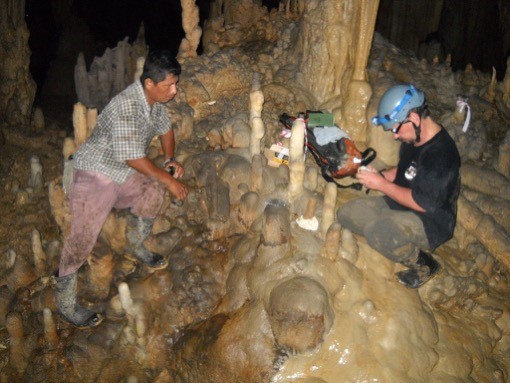 UXBENKA, BELIZE—An interdisciplinary team has discovered that unpredictable changes in seasonal rainfall may have contributed to the disintegration of the political order at some ancient Maya cities, according to a University of New Mexico report. The team, which included University of New Mexico archaeologist Keith Prufer and Potsdam Institute for Climate Impact Research’s Tobias Braun, was able to analyze seasonal changes in carbon and oxygen isotopes over the last 1,600 years in a stalactite from a cave near the ancient Maya city of Uxbenka. The isotope record allowed them to reconstruct patterns in precipitation and showed that rainfall was highly unpredictable between A.D. 700 and 800, a period that coincides with the decline of many ancient Maya societies. "Farming in subtropical Central America is tough because freshwater is only available during the summer rainy season,” says Braun. “Changes of onset and intensity of the rainy season can have serious repercussions for Central American societies.” Read the original scholarly article about this research in Nature Communications Earth & Environment. To read in-depth about women rulers in the ancient Maya world, go to “Jungle Realm of the Snake Queens.”
UXBENKA, BELIZE—An interdisciplinary team has discovered that unpredictable changes in seasonal rainfall may have contributed to the disintegration of the political order at some ancient Maya cities, according to a University of New Mexico report. The team, which included University of New Mexico archaeologist Keith Prufer and Potsdam Institute for Climate Impact Research’s Tobias Braun, was able to analyze seasonal changes in carbon and oxygen isotopes over the last 1,600 years in a stalactite from a cave near the ancient Maya city of Uxbenka. The isotope record allowed them to reconstruct patterns in precipitation and showed that rainfall was highly unpredictable between A.D. 700 and 800, a period that coincides with the decline of many ancient Maya societies. "Farming in subtropical Central America is tough because freshwater is only available during the summer rainy season,” says Braun. “Changes of onset and intensity of the rainy season can have serious repercussions for Central American societies.” Read the original scholarly article about this research in Nature Communications Earth & Environment. To read in-depth about women rulers in the ancient Maya world, go to “Jungle Realm of the Snake Queens.”
Unpredictable Rainfall May Have Helped Destabilized Ancient Maya Societies
